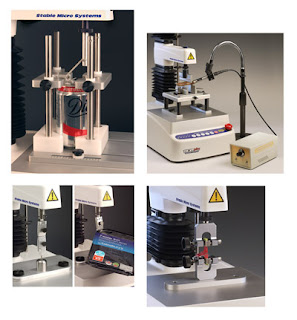They are not aware of the meticulous testing that has gone into every stage of their meal, from the packaging down to the wheat flour used to make their bread. It is no surprise that food manufacturers focus so much of their effort into tailoring these items so they are a perfect compromise between cost and quality, to be pleasing to the customer but not expensive to manufacture.
 |
| • Ring Pull Rig • Acoustic Envelope Detector • Articulated Tensile Grips • Tensile Grips |
The range of Texture Analysers by Stable Micro Systems makes this process as easy as possible, with analysis and batch comparison performed at the press of a button.
When sitting down to lunch, the first thing the customer will do is open their can of soda. There is an expectation for a pleasing ‘fizz’ sound when the ring pull breaks the seal – this suggests freshness as a lack of fizz means a drink has gone flat – and a crunch as the tab is pressed back against itself.
This process can be mimicked instrumentally using the Ring Pull Rig – a tensile test that measures the force to open a can. The Acoustic Envelope Detector is a sensitive microphone used to record each sound produced and displays it on a graph in sync with the test data. Finally, the video capture system, a camera that records a video of the test in motion, completes the puzzle. The opening of the can has mechanical, audio and visual data recorded for a thorough analysis.
Next, they grip the corner of their sandwich box and peel it back. They may be in a rush so will appreciate a sandwich that opens easily, and will certainly not make a repeat purchase of a sandwich in a package whose tab rips off before peeling. The force needed to perform this action can be measured using Articulated Tensile Grips. After this, they put the crisp packet to test by pulling apart the corrugated seam at the top of the bag using standard Tensile Grips. The force required to open the seam can be measured by performing tensile peel tests on small sections of the seal.
The satisfaction they get from eating their sandwich depends on many factors, and texture is one of the most important. The bread must be springy, the lettuce crisp and the salami tender. Bread springiness can be measured using a resilience test. A bread sample is compressed to a given force under a large, flat Cylinder Probe and held there. The drop in force over time gives the springiness. A low drop corresponds to a more resilient sample that would feel springy between the hands and in the mouth.
 |
| • Bread Firmness test • Multiple Puncture Probe • Warner Bratzler Blade • Ottawa Cell |
A winning bag of crisps can be determined using an Ottawa Cell. A chosen weight of crisps is put inside the cell and compressed in bulk. A moderate force and many small fracture events will generally correspond to a pleasing sample. If you want a queue next to your meal deal counter at 12:30pm Monday to Friday, it is time to buy a Texture Analyser.
We can design and manufacture probes or fixtures for the TA.XTplus texture analyser that are bespoke to your sample and its specific measurement.
Once your measurement is performed, our expertise in its graphical interpretation is unparalleled. Not only can we develop the most suitable and accurate method for the testing of your sample, but we can also prepare analysis procedures that obtain the desired parameters from your curve and drop them into a spreadsheet or report designed around your requirements.
For more information on how to measure texture, please visit the Texture Analysis Properties section on our website.
 The TA.XTplus texture analyser is part of a family of texture analysis instruments and equipment from Stable Micro Systems. An extensive portfolio of specialist attachments is
available to measure and analyse the textural properties of a huge range of
food products. Our technical experts
can also custom design instrument fixtures according to individual
specifications.
The TA.XTplus texture analyser is part of a family of texture analysis instruments and equipment from Stable Micro Systems. An extensive portfolio of specialist attachments is
available to measure and analyse the textural properties of a huge range of
food products. Our technical experts
can also custom design instrument fixtures according to individual
specifications.No-one understands texture analysis like we do!
To discuss your specific test requirements click here...
 |  |  |


No comments:
Post a Comment